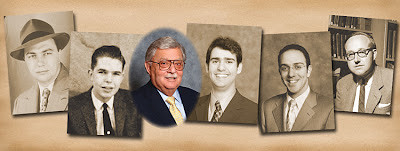
PREV ARTICLE
NEXT ARTICLE
FULL ISSUE
PREV FULL ISSUE
YOUNG NUMISMATISTS AT STACK'S
Harvey Stack's latest blog discusses the young numismatists over the years who were welcomed and encouraged during their visits to the firm's New York shop. Here are some excerpts.
-Editor

From the first time I worked (part time) at Stack's, I saw my father, Morton, and my Uncle Joe give special attention to young, budding collectors when they visited our offices and retail shop in the early 1940s. My cousins Ben and Norman, Joseph Stack's sons, and I, Morton's son, were instructed and encouraged to help and pay attention to the young people, for they could become the numismatists and friends of the future. The roster is long and many of the names legendary, but I will try to give some idea of the wonderful visitors we received through the decades. I start with Cornelius Vermeule, who came to visit us in the late 1930s and early 1940s, accompanied by his father, as he added coins to his collection. Cornelius was a lover of classical ancient coins, U.S. coins (which he received from this grandfather and father), and was excited by coins of the Orient. For a few summers Cornelius worked at Stack's sorting and cataloging coins. He went off to military service early in World War II. He was stationed in Japan at the end of the war and was selected, with his close friend Norman Jacobs, to inventory the Bank of Japan's numismatic holdings. Upon returning to the United States, a new book was written entitled 'Japanese Coinage' by Vermeule and Jacobs, published by Stack's. Cornelius worked for us part-time in the late 1940s and then went on to be the Curator of Numismatics at the Boston Museum of Fine Arts. Later he became director of that museum. Stack's is very happy that one of our protégés went on to fame. Another name, John J. Ford, Jr., was 'a wiz' of a numismatist, who worked part-time with Stack's prior to World War II. He did a lot of apprentice work in our offices. He entered the U.S. Army in 1942 and remained in Military Intelligence until he came home in 1946. His love for coins brought him back to Stack's where he worked until late 1947. He was encouraged as a youth and became a celebrated numismatist for nearly 60 years. Stack's always kept his friendship and relied on his great 'numismatic brain' to enhance its catalogs. He always said 'I went to Stack's as a youngster and graduated a numismatist.' His famous collection of mostly early Americana was featured in 21 catalogs, issued by Stack's. Stack's always encouraged John, and we are duly proud of his close association and long friendship with the Stack family. One of the most exciting development programs we provided in the 1940s, 1950s, and 1960s was to be visited by the school coin club of the Pingry School, a well-known private school in New Jersey. During that time the history and economics teacher was Edward Knoke. He found by forming a coin club, he could advance the influence on his students of history and economics through numismatics. The members of the club had collections of classical coins through to modern world coins. Once a month or every six weeks on Saturday, the club would make a field trip to New York City. The first stop was always the Chase Money Museum, where curator Vernon L. Brown showed them the new displays and generally gave them a short talk. Next stop was Stack's where they were welcomed, shown coins of their interest, and mingled with the famous collectors who visited Stack's each week. The Stack family and staff welcomed these budding collectors. To this very day, some of the members of the Pingry School Coin Club are still collectors. Harvey adds: It makes me remember all the years I spent in the shop at Stacks and some of the people we served and try to encourage to be collectors and some became great dealers. I hope everyone enjoys reading it. For me, it was really a personal trip "down memory lane"
QUICK QUIZ: OK, so who can name all the numismatists pictured in the image accompanying the article?
-Editor
Bruce W. Smith adds a question: Harvey says that after World War II, Cornelius Vermeule and Norman Jacobs were selected to inventory the Bank of Japan coin collection. I would like to know, for whom did they do this inventory? Who selected them and why? For what reason was the collection inventoried? And what was the result? There have long been rumors that Jacobs and Vermeule somehow acquired the Bank of Japan's collection of Japanese coins. Both of them have passed away now, so we can't ask them about it, and both of their collections have been sold. As far as I know, the Bank of Japan still has its collection. So what was the basis for those rumors?
To read the complete article, see:
Remember When: Stack's Always Encouraged Young Numismatists
(stacksbowers.com/Blogs/remember-when-stacks-always-encouraged.html)
The Numismatic Bibliomania Society is a non-profit organization promoting numismatic literature. See our web site at coinbooks.org. To submit items for publication in The E-Sylum, write to the Editor at this address: whomren@gmail.com To subscribe go to: https://my.binhost.com/lists/listinfo/esylum All Rights Reserved. NBS Home Page Contact the NBS webmaster 
|